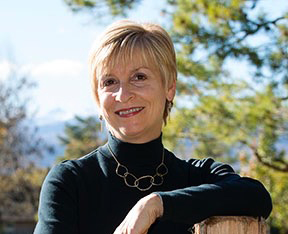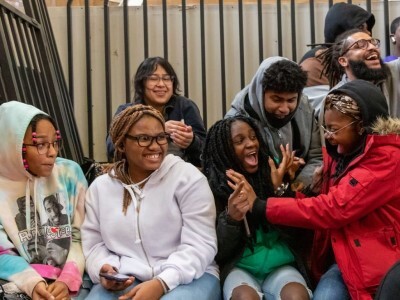Enabling Change
Mighty in Presence: The Teacher Innovator at Work
Topics
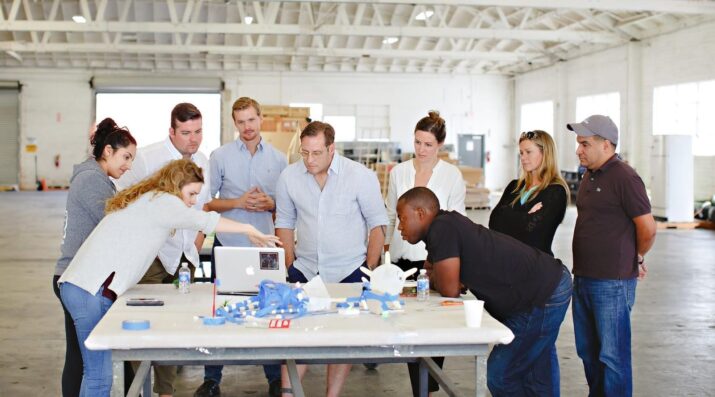
Next generation learning is all about everyone in the system—from students through teachers to policymakers—taking charge of their own learning, development, and work. That doesn’t happen by forcing change through mandates and compliance. It happens by creating the environment and the equity of opportunity for everyone in the system to do their best possible work.
Practitioner's Guide to Next Gen Learning
How can an individual teacher support school- or district-wide plans to redesign teaching and learning? Teacher Christina Classen of Thomas B. Doherty HS in Colorado Springs is a champion for innovation at her school.
Classes are in session right now, so the halls of Thomas B. Doherty High School in Colorado Springs, CO, are empty and nearly silent. From behind the walls of the classrooms we pass, only the rumbling, low tones of the educators and the occasional soprano solo of a student’s question break the quiet. Then we turn a corner and hear it: the din of many people talking all at once. Their youthful voices are quick, loud, and eager. Some might be described as urgent. This is Christina Classen’s 21st Century Geography and World History class, where the freshmen are “studying” the War on Terror.
In some respects, this windowless classroom looks the same as a traditional high school from Anywhere, USA, and anytime in the last 25 years: the same whiteboards on the walls, the same beige-and-chrome student desks. However, what happens in this familiar-looking space bears little resemblance to traditional pedagogy. Today, those desks have been clumped together and shoved to the corners like so many encumbrances. Not a single desk is occupied, anyway, because the students are all on the floor.
Groups are clustered around cards announcing events like “Al Qaeda formed,” “Patriot Act,” or “USS Cole attacked.” Using their notes as references, they negotiate and gesticulate, trying to sequence the cards exactly right, for this timeline activity is a prerequisite to diving more deeply into the cause-and-effect processes of change over time.
A petite woman with dark blonde hair barely tamed into a bun darts from group to clamoring group, giving encouragement and status reports. “Closer, but two cards are still out of order,” she says. A few students groan while others frantically flip through their notebooks. Make no mistake: this is a competitive bunch, and no one is standing on the sidelines.
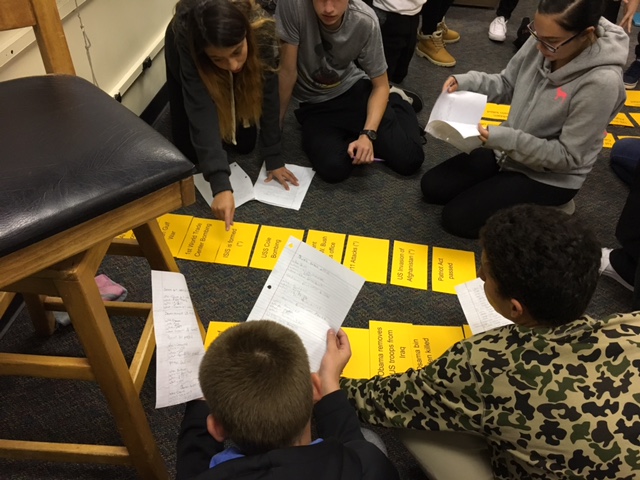
For this edition of Friday Focus: Practitioner’s Guide to Next Gen Learning, we caught up with Christina, her principal, Kevin Gardner, and Scott Fuller, next generation learning coordinator for Colorado Springs School District 11, to talk about her work as a champion for innovation at Doherty, and the integral part she and other forward-thinking educators play in D11’s implementation of next gen learning. In particular, we were interested in their insights on these questions:
- How can an individual teacher support school- or district-wide plans to redesign teaching and learning?
- What does next gen learning mean and how is it different from traditional schooling?
- What kinds of support do educators and schools need to transform their practice?
- What advice and resources would you share with others embarking on a similar journey?
From Compliance to Innovation
D11, historically a very traditional district, joined up with the Colorado Education Initiative (CEI) and a coalition of district and state-level partners to form the Colorado Coalition and launch the NGLC Regional Fund effort in Colorado. D11 is in its third year of next gen learning implementation, but schools across the district are at different waypoints in this journey. As Scott points out in a recent blog post, D11 has a common set of learner outcomes and next gen learning ecosystem characteristics, but he and his fellow educators know that “cookie cutter” models do not work. Each site develops it own vision and priorities. Educators like Christina are encouraged to be artists and to experience passion for what they are doing to transform teaching and learning at the local level.
Kevin explains that for Doherty, one of a cohort of ten D11 schools in their first year of implementation, the key next gen learning goals for the year are centered on student engagement: student voice, choice, and responsibility for learning. “This year, we are seeing students talking more, presenting more, researching more. It’s not busy work. They are engaged in the active tasks of learning.”
School-wide initiatives, like student-led conferences (brand new this year), exemplify and support this shift, but Kevin gives a great deal of credit to individual teachers like Christina. Calling them the “first followers,” he acknowledges how scary it can be to cede some control of the classroom to students “when we’ve drilled compliance into everyone.” In the past, he says, D11 was a “top-down, innovation-averse district. As evaluators we’ve rewarded straight rows and high test scores. We tended to say ‘no’ and that gave us compliant teachers and students.”
D11 school leaders and educators are trying to change that script and embrace what Kevin calls the “logistics of yes.” In his eyes, Christina is ideally suited to be a champion for next gen learning, in part because “her energy and commitment to kids is over the top.” It also helps that she, like her principal, previously worked at the innovative and creative Castle View High School in nearby Castle Rock, which was featured in the documentary Most Likely to Succeed. “We both know where we want to go, and now we are figuring out how to get there, how to push a traditional place into the future.”
“I Never Wanted to Be a Teacher”
Christina’s work as an educator is built on an unshakable belief that “human beings are wired for curiosity—every kid is cut out for learning.” She is now in her tenth year of teaching, but education was not her first choice as a career. “Honestly, I never wanted to be a teacher. I had a horrible experience in high school. I hated the game of meaningless memorization and regurgitation.” Even so, Christina re-discovered her passion for learning when she began supplementing her own kids’ classroom experiences at home. Seeing their frustrations with traditional schooling, she decided to become a teacher to “help kids authentically fall in love with learning.”
Her journey as “a true transformational educator” blossomed, however, when she helped design and implement Castle View’s project-based learning model and participated in training sponsored by High Tech High in San Diego, California. Visiting next gen learning schools throughout the country, she witnessed the power of authentic, real-world projects: “When students presented to the community instead of just us, we were inspired by their motivation and investment in their projects. They couldn’t stop learning!”
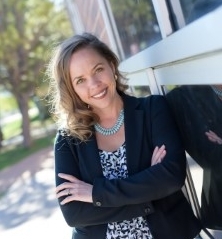
Christina’s personal journey—from reluctant student to innovative educator—offers a unique perspective on what next gen learning is and what it means for her students, as well as guidance for fellow educators setting out on similar journeys. We’ve captured some of her story and insights below:
How would you define next gen learning? What are the key elements and priorities for your practice?
To me next gen learning is:
- Personalized based on student interests as well as the way they learn most effectively
- Flexible so students can try different things and learn about hidden passions and talents
- Interactive, engaging, and relevant to their lives
- Organized around student progress and learning goals
- Collaborative with teachers, other students, their families, and the community
- Supportive, with built-in, natural support structures to provide as much or as little help as an individual student needs
- Challenging but achievable for each kid based on where they’re at
- Available to all students regardless of race, ability, or socioeconomic status
- Ideally tech-enabled, but could be done without
What does that look like in practice? How is what you provide to your students different from what they might experience in a more traditional classroom?
My vision of a traditional classroom is one like I learned in. Sit and get. Students are quiet, listening to the teacher, writing down the notes, which they will take home and attempt to memorize so they can perform well on a multiple choice, T/F, short answer test to show what they learned. Then six weeks later they are on to a different topic and probably can’t tell you much about what the last unit of study was about. The information is being taught because it is what the teacher is supposed to “cover.”
When students sit and get like that, I might have an illusion of control in my classroom. But that’s what it is—an illusion. Walking down the hallways you will still hear students talk about how much they hate school and they can’t wait to get out. Why are we not striving to make school the best seven hours of a kid’s day? We must stop approaching it as, “I had to endure the pain and agony of school...so do you.”
Our kids deserve more. I am in love with that buzz of chaos that happens in my room when students are excited and learning. My classroom is loud. Students are discussing, processing, creating, or practicing for a presentation. We take very few tests because I am not confident in the data I get back. I want to see students demonstrate their learning through presentations to real experts or community members. They tend to work harder on their products and have to solve lots of problems along the way.
Could you share a story of a particularly powerful next gen learning experience?
I have so many stories, but one of my favorites is from an interdisciplinary project on the war in Vietnam. Some of my students were reading The Things They Carried by Tim O’Brien. We were also analyzing documents about French Indochina and watching clips of movies [about Vietnam]. The students were appalled at how the soldiers were treated when they returned home. We had a good relationship with our local veteran’s association, so one of our freshmen, Hailey, decided to express her appreciation for Vietnam vets and their service to this country. She wanted to give them a “welcome home,” since they didn’t get one before. We worked with some local businesses, the newspaper, and the VA.
Hailey and other students planned and put on a “Welcome Home” breakfast for about 100 local Vietnam vets. The students made signs to hold as the vets arrived, took their coats, escorted them to their seats, served them a full pancake breakfast, and even performed speeches of thanks. We had a local nurse talk about PTSD and the importance of treatment. At the end the most touching moment (it still chokes me up now) is when all 100 vets gave the students a standing ovation in appreciation for all they had done. After that, vets offered to be interviewed by our students. They shared pictures, mementos, and personal items. That was one of the greatest experiences of my teaching career.
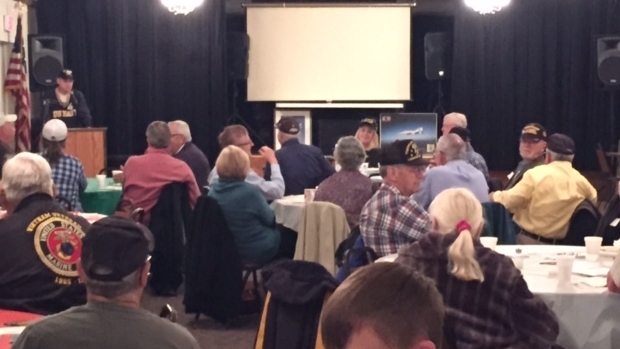
Interdisciplinary project: students organize a “Welcome Home” breakfast for Vietnam vets
The faces of hundreds of former students flash before my eyes. They are all a part of my journey. They are why I go back every day. We aren’t just sharing time while they learn about history in my classroom. I am watching them learn about the past mistakes of humanity and pleading with them to become better people.
People interested in rethinking education often ask, “Where do we start?” What advice would you give to anyone engaging with the challenge of reimagining schools?
Change is so hard. It is easy to get discouraged and go back to the easy. This type of teaching is the hardest work I’ve ever done, but I have been incredibly blessed with very supportive administrators in my current and previous schools. I have been provided with additional technology support to make my classroom operate more effectively. I’ve been given leeway to test out teaching curriculum differently. For example, my modern warfare unit is presented in reverse order, starting with the present and moving backwards to explore causes.
It helps to adopt a “hack mindset” in implementing important changes to your system. Get small pockets of teachers on board. Support, support, support them! Areas of need might be Professional Learning Communities and planning time, removing restrictive curriculum requirements, and asking teachers to be involved in planning the future direction of your school. Keep encouraging others to change, but don’t be surprised when it doesn’t catch on right away. Don’t give up!
Tap into the power of your communities. Survey students and publish the results. They are the users, but sometimes we overlook their voices. Also, positive partnerships with parents are essential. Host forums to challenge mindsets about education and all that we’ve bought into for years: standardized tests, boxed curriculum, and measuring success through GPAs. The more I gently challenge the preconceived notions and narratives we share about education, the more I find that many people know in their hearts that the system is ill equipped to prepare our kids for the future. But they just can’t picture what it might look like in a different context.
Aside from parents, you must tap into your local business community. They will employ your students in the future—why should they not be involved in supporting schools? Allow students opportunities to interview industry experts for projects. Have experts attend student showcases and provide feedback on student work, as well as much-needed resources in the area of technology. Have local industries adopt a school. When schools are more successful, everyone wins!
Christina’s “Go To” Resources
In addition to pioneering next gen learning in her own classes, Christina provides training on project-based learning and inquiry to other D11 educators. Here are some favorite resources that have inspired her and her colleagues:
- School Retool by IDEO, Stanford d.school, and Hewlett Packard: A toolkit that introduces the “hack mindset” and gives exercises for innovation and building empathy for students
- Cult of pedagogy: Blogs, podcasts, and videos for unabashed “teacher nerds”
- Buck Institute for Education: Community, articles, and resources on project-based learning, including a searchable database of project ideas
- Facing History: Resources for helping students learn about hatred and bigotry so they can stop them from happening in the future
- Power of Vulnerability by Brene Brown: Must-see TED Talks
- Every Kid Needs A Champion by Rita Pierson: Must-see TED Talks
- Do Schools Kill Creativity? by Ken Robinson: Must-see TED Talks
- The Puzzle of Motivation by Daniel Pink: Must-see TED Talks

